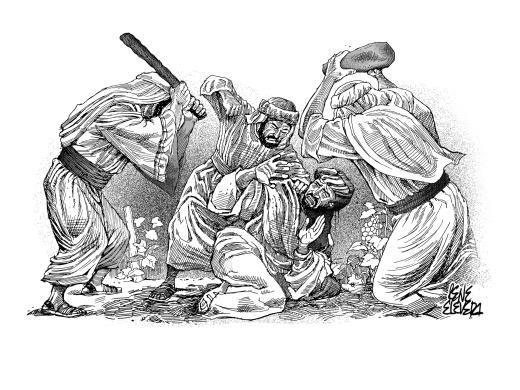In the 1790s, Robert Bowyer, a British miniature painter, published an illustrated edition of the Bible, which came to be known as “Bowyer’s Bible.”
It included engravings by James Fittler done after the paintings of the Old Masters, among them “The Wicked Husbandmen,” which portrays a scene from one of Jesus’ parables narrated by Matthew in his Gospel.
“Hear another parable. There was a landowner who planted a vineyard, put a hedge around it, dug a wine press in it, and built a tower. Then he leased it to tenants and went on a journey.
When vintage time drew near, he sent his servants to the tenants to obtain his produce. But the tenants seized the servants and one they beat, another they killed, and a third they stoned. Again he sent other servants, more numerous than the first ones, but they treated them in the same way. Finally, he sent his son to them, thinking, ‘They will respect my son.’
But when the tenants saw the son, they said to one another, ‘This is the heir. Come, let us kill him and acquire his inheritance.’ They seized him, threw him out of the vineyard, and killed him. What will the owner of the vineyard do to those tenants when he comes?” They answered him, “He will put those wretched men to a wretched death and lease his vineyard to other tenants who will give him the produce at the proper times.”
The engraving depicts the moment when the evil tenants or husbandmen gang up on the landowner’s son. One raises a fork with two pointed prongs, ready to strike the son from behind. At the right, another tenant, from the way he carries a similar instrument, has the same murderous intent as the one at the back. The landowner’s son, however, looks unperturbed and accepting of his fate.
Obviously, the parable sums up the history of salvation. In his work, “Against Heresies,” St. Irenaeus wrote that the vineyard meant the human race, which God planted when he formed Adam and chose Abraham and the fathers. This vineyard he let out to husbandmen when he established the Mosaic dispensation.
“He hedged it round about, that is, He gave particular instructions with regard to their worship: He built a tower, [that is], He chose Jerusalem: He dug a winepress, that is, He prepared a receptacle of the prophetic Spirit.” And then he sent prophets, who “sought the fruits of righteousness,” but these the wicked husbandmen maltreated.
Last of all, “He sent to those unbelievers His own Son, our Lord Jesus Christ, whom the wicked husbandmen cast out of the vineyard when they had slain Him.” Because of this, God rejected them and gave “to the Gentiles outside the vineyard the fruits of its cultivation.”
Lewis Carroll writes that, when Alice saw the book her sister was reading, and it contained nothing but text, she said, “What is the use of a book without pictures or conversations?”
Bowyer must have had a similar thing in mind when he published his grangerized Bible, inserting there engravings and prints as illustrations.
Before the discovery of print, people may have received much of their religious instruction through sacred art.
For instance, one contemplating the engraving, “The Wicked Husbandmen,” in Bowyer’s Bible would at once see the wickedness of the crowd around the young man, and then, reading and reflecting on the parable, come to a love of Christ – and take to heart St. Irenaeus’ counsel: “Cleanse your ways and your doings, execute just judgment, and look each one with pity and compassion on his brother.”
Disclaimer: The comments uploaded on this site do not necessarily represent or reflect the views of management and owner of Cebudailynews. We reserve the right to exclude comments that we deem to be inconsistent with our editorial standards.

